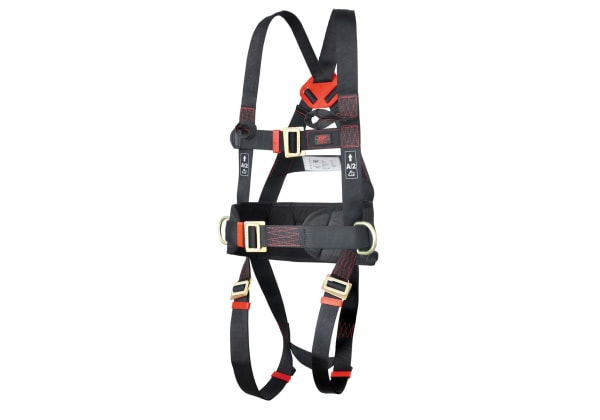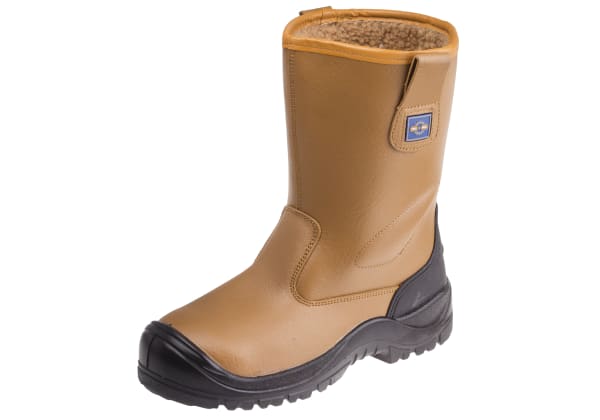- Published 17 Mar 2025
- Last Modified 17 Mar 2025
- 7 min
Equipment Used for Working at Height
When employees are working at height, there's an increased risk of an incident for the public, your staff, and your business. Discover how to mitigate this risk and make working at height safer for all.

Reviewed by David Carmichael, Solution Engineer (April 2024)
Working at height is routine in many sectors, but involves inherent risks. Therefore, equipment for working at height that ensures workers' safety is essential and underlines the importance of using the right equipment for the job.
There is always a risk of objects falling when personnel work at height. A dropped tool can have severe consequences for the individual and the wider business. If a tool falls, it can pose a health and safety risk to those below, damage expensive equipment, or even halt production. In all instances, the tool must also be retrieved which takes time and inevitably impacts productivity.
From personal protective equipment (PPE) to fall arrest systems and access tools, equipment used for working at height must be engineered to meet the highest safety standards and provide dependable protection for those working at height.
This guide will detail the different types of equipment used for working at height. It will explain what is working at height, highlight the significance of each piece of equipment in maintaining safety, discuss the risks involved, and guide you on selecting and using the equipment safely.
Let's get started and find the best solutions for your working-at-height needs.
What is Working at Height?
Working at height refers to any work activity performed at a certain distance above ground level, where a fall could lead to injury. This includes working on rooftops and elevated platforms, using scaffolds, climbing ladders, or scaling tall structures.
Importantly, working at height doesn't necessarily imply extreme heights such as skyscrapers or tall structures. Even a few feet above ground can pose significant risks if appropriate safety measures are not implemented.
When operating at height, prioritising safety is crucial to preventing accidents and injuries. This involves using suitable equipment specifically designed for working at height. Such equipment ensures stability, fall protection, and secure access to elevated areas.
What are the Hazards of Working at Height?
Working at height involves several hazards that can result in accidents and injuries if proper safety measures are not followed. The use of appropriate height equipment plays a crucial role in ensuring workers' safety in such situations.
The primary risk of working without suitable equipment is falling from a height, which can result in severe injuries and even fatalities. By using the right equipment, such as harnesses, lanyards, and safety nets, workers can minimise the risk of falling and protect themselves from harm.
Understanding the hazards of working at height is paramount to mitigating risks. Fall-related incidents are a leading cause of workplace injuries and fatalities. Therefore, providing suitable equipment for working at height and strictly adhering to safety guidelines is crucial.
Understanding HSE Work at Height Regulations
In the UK, employers are legally obligated to ensure the health, safety, and welfare of their employees as per the Health and Safety at Work Act 1974. This includes providing suitable and well-maintained equipment for working at height.
The Work at Height Regulations 2005 outline employers' legal responsibilities to ensure worker safety and provide proper safety equipment for employees who work at height. Employers are required to assess the risks associated with working at height, implement suitable control measures, and provide appropriate equipment for working at height.
By complying with and adhering to these legal obligations, employers can protect workers' safety and well-being and avoid potential legal repercussions.
Working at Height PPE
Personal Protective Equipment (PPE) is crucial to enhancing safety while working at height. It plays a vital role in ensuring worker and employee safety.
Harnesses are essential personal protective equipment when working at height. They are designed to evenly distribute the force of a fall across the body to minimise injury risk. There are various types of safety harness available, each designed for different uses and applications:
Full body harnesses are commonly used for tasks that require prolonged height work
Vest harnesses are preferred for tasks involving limited movement
Construction harnesses are specifically designed for the construction industry, offering additional features such as tool belts and pouches
Choosing the right harness depends on the nature of the job and the level of comfort and mobility required. It's crucial to ensure that the harness fits properly and is correctly adjusted to provide maximum safety.
What is a Fall Arrest System?
Fall arrest systems are a critical component of height safety. They are designed to protect workers from falls and reduce the risk of injury or death. This is done by limiting the force applied to the body during a fall. The system includes fall arresting equipment, retractable fall arrest systems, and anchoring devices.
Fall Arresting Equipment
Fall arresting equipment is designed to prevent falls and minimise injury risk in case of a fall, ensuring safe working at elevated heights. It's intended to stop a fall in progress and minimise forces exerted on the body during a fall.
Retractable fall arrest systems consist of a lifeline that can be extended or retracted as needed. They are compact and lightweight, making them suitable for workers who need to move around while working at height. The anchor point is another critical component of a fall arrest system, used to secure the lifeline and prevent it from pulling out or breaking during a fall.
What is Access Equipment?
Access equipment comprises various tools and devices that offer safe and efficient access to elevated areas. Whether you are a professional tradesperson or an industrial worker, having the right access equipment is crucial for your safety and productivity.
Types of Access Equipment for Working at Height
There are various types of access equipment available for working at height, each designed to suit different tasks and environments. These include scaffolding, ladders, Mobile Elevated Work Platforms (MEWPs), fall arrest systems, and safety equipment such as harnesses and lanyards. It's crucial to choose the right equipment based on your task's specific requirements and safety levels.
Selecting and Using Working at Height Equipment Safely
Selecting the right equipment for working at height is critical for safety and efficiency. Different tasks require specific equipment, so choose wisely. Consider the nature of the task, the height, accessibility, and duration of the job to determine which equipment is most suitable.
Once you've chosen the appropriate equipment, it's essential to use and maintain it safely. The following tips will help you ensure your safety when working at height:
- Regular inspections should be performed to check for damage or wear and any issues should be addressed promptly
- All equipment should be correctly assembled, operated, maintained, and serviced as per the manufacturer's instructions
- Safety harnesses should be worn whenever there is a risk of falling
- Harnesses should be worn properly, fitted correctly, and securely fastened before starting any task
- Ensure that equipment weight limits are not exceeded
By selecting the right equipment for the task, using and maintaining it safely, and using safety harnesses effectively, you can minimise the risks associated with working at height and ensure a safe working environment.
Summary
Choosing quality, reliable equipment is essential for safety and efficiency. At RS, we offer a broad range of top-tier equipment designed to meet the needs of professionals working at height. From safety harnesses to fall arrest systems and access platforms, we prioritise safety by offering products built to withstand a wide range of applications and workplace environments.
Our products meet the highest safety standards, offer exceptional performance, and are suitable for a wide range of industries. Our team of experts is also available to provide guidance and support, ensuring you find the perfect solution for your specific requirements.
Explore our range today and choose RS for reliable, high-quality equipment for working at height.


